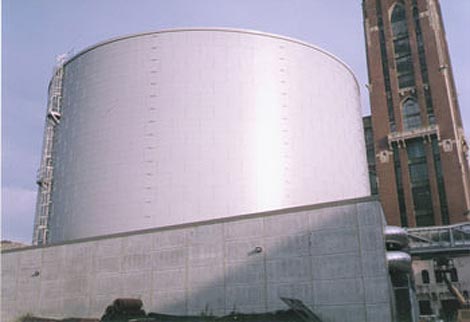
The 8 million gallon tank providing thermal energy storage for McCormick Place and a nearby Digital Realty Trust data center building (seen in background).
A California power authority will buy thermal energy storage systems and distribute them to commercial customers, hoping the move will shift up to 50 megawatts of daily electricity usage to off-peak hours.
Although the project is targeting small to medium-sized customers, the concept may hold promise for the data center industry, where thermal storage is lightly implemented but offers the potential for significant savings on power bills. Utilities in some states are already offering incentives to data centers that reduce energy use by virtualizing servers or upgrading to more efficient equipment.
Thermal energy storage can reduce costs by allowing companies to run air conditioning systems at night, when power rates are cheaper. During daytime hours, when demand on the grid is higher and electricity is mor expensive, these customers can tap the energy storage system, which serves as a "battery" that substitutes for the air conditioner. Thermal storage systems typically use ice or liquid coolant that can be chilled and then used in heat exchange systems.
The Southern California Public Power Authority (SCPPA), which serves the Los Angeles market, announced an agreement Wednesday with vendor Ice Energy that will place the company's storage systems at customer sites to create a "distributed energy storage project." Ice Energy's rooftop units integrate with air conditioners from leading HVAC vendors, including Carrier, Data-Aire, Lennox, Trane and York.
Changing When Power is Consumed
“By using storage to change how – and more importantly when – energy is consumed by air conditioning, we can offset enough peak demand in the region to serve the equivalent of 10,000 homes," said Bill Carnahan, Executive Director of SCPPA.
“This project includes all of the aspects we look for: managing electrical consumption, improving system efficiency, reducing greenhouse gases, and creating regional jobs for our communities," added Jeffrey Byron, Commissioner of the California Energy Commission.
Thermal storage also offers an opportunity could also extend to data centers, which are among the largest energy users. ermal storage also offers potential savings for data centers.
Byron was a panelist at the Data Center Energy Efficiency event held in November by the Silicon Valley, where PG&E's Mark Bramfitt urged a closer look at energy storage. “I think there’s a tremendous opportunity for data centers in thermal storage,” he said. “I think thermal energy storage offers this industry a reliability story.”
Bramfitt has since left PG&E to consult in the field, but helped implement incentvies for data center operators that reduced their power draw from PG&E by using virtualization or Energy-Star-rated servers.
Here's a look at several existing thermal storage implementations in major data centers:
- At i/o Data Centers' Phoenix ONE data center, the chillers cool a solution of water and 28 percent glycol. The thermal storage tank contains Cryogel ice balls, 4-inch polyethylene spheres filled with water. The balls freeze when the system is charging at night, and then cool the glycol solution during the day. The glycol solution is then pumped through a heat exchanger, which chills water in a separate loop used in the data center. The first phase of the system provides 12,000 ton hours of thermal storage. A second phase will eventually boost capacity to 24,000 ton hours.
- Digital Realty Trust's carrier hotel at 350 East Cermak in Chicago is supported by a thermal storage system featuring an 8.5 million gallon tank of a refrigerated brine-like liquid. The huge tank also supports the Metropolitan Pier and Exposition Authority (MPEA), including the nearby McCormick Place Exposition Center and Hyatt Regency Hotel . The Trigen facility chills the liquid to 32 degrees and pumps it to the nearby buildings, which use it in a heat exchanger system to support their on-site cooling infrastructure. For Digital Realty, that includes a water-and-glycol system and enormous air handlers that deliver chilled air to tenants




